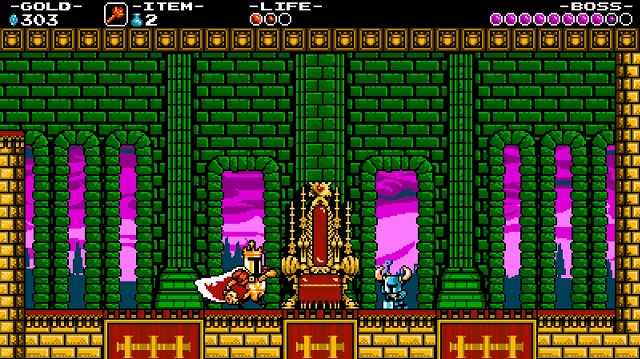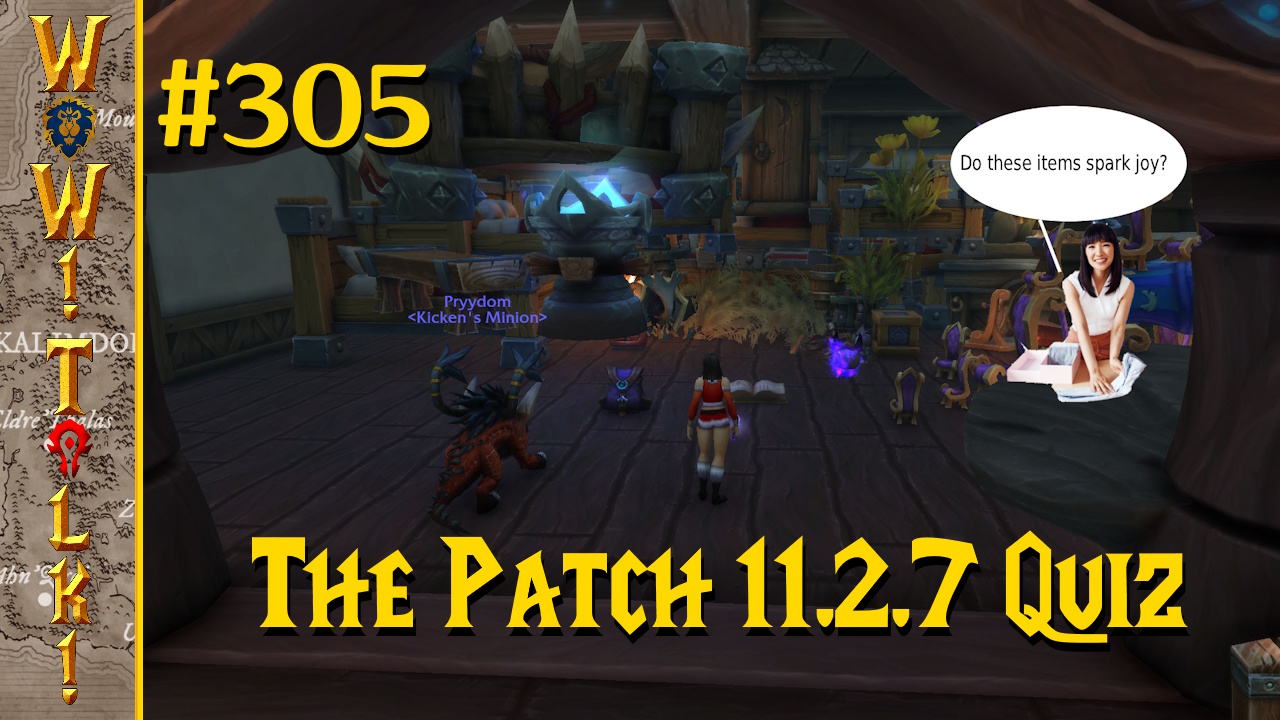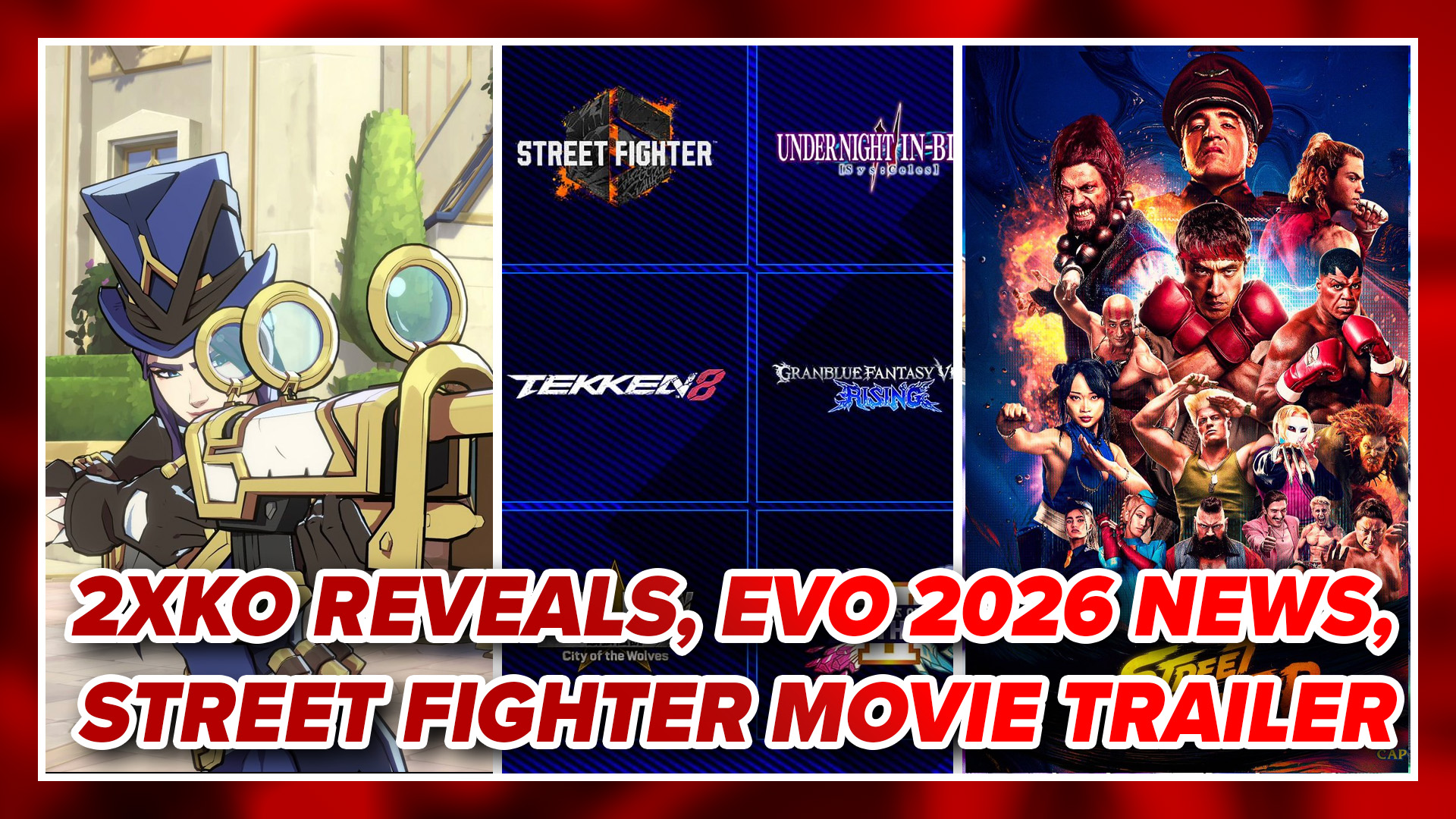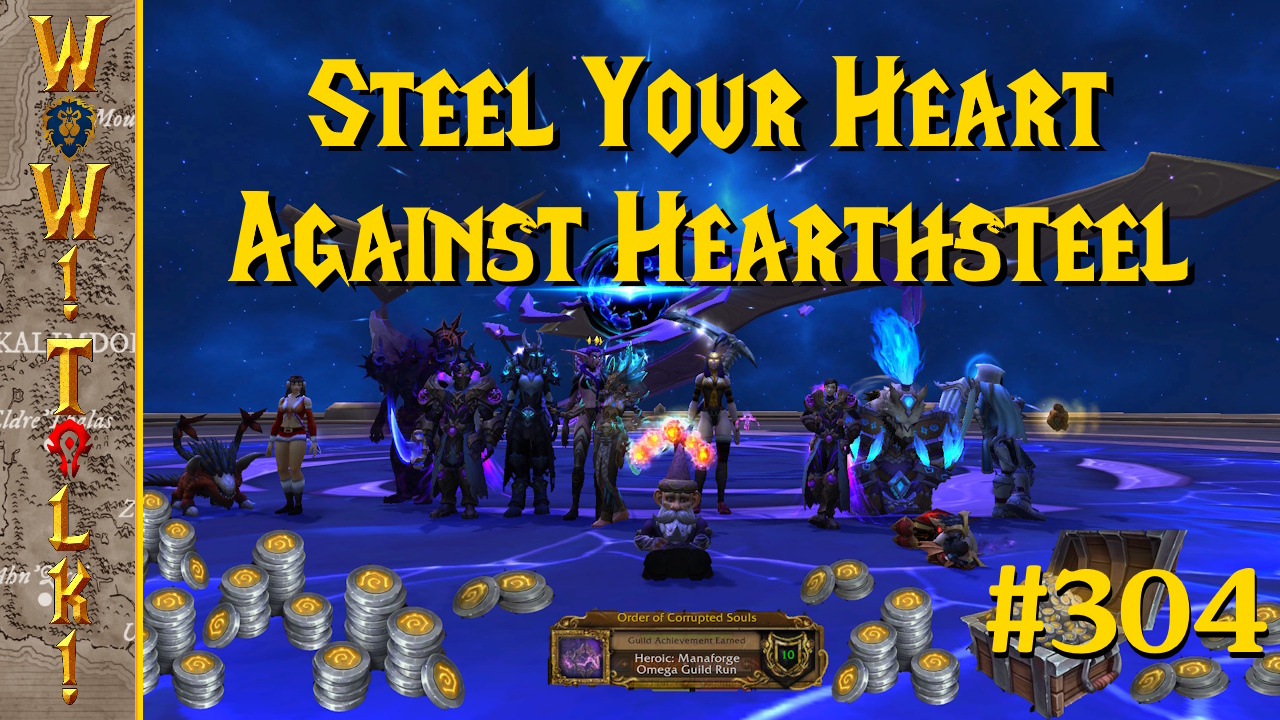When my buddies and I got together as kids we used to talk about how you would make the perfect game. We’d talk about pulling elements from games like Mega Man, Castlevania, and Super Mario Bros together, mixing combat styles, secrets, power-ups, and things like that all into one massive dream game that would have the best of everything from our personal favorites. None of us are game devs, so it was all just talk. Yacht Club Games are game devs, though, and I can only assume their game, Shovel Knight, is the result of similar conversations. Pooling many of the best ideas and concepts in retro gaming history, mingling them with modern computer magic, and still adhering to design rules from the games it draws inspiration from, it is required playing for fans of the NES. I asked if Shovel Knight would be the Mega Man 2 of this century when I first played this game at PAX East 2013. Yes, it is.
It’s not long before you’re into the thick of things, so you should know what’s up. You’re fighting with a shovel instead of a sword in this game, but the knight uses it like a pro. You can swing it straight ahead of yourself, which has an interesting side effect of knocking the player back a bit. It gave the swing a real weight that you can feel when you hit someone so hard that you move back a step, one that can be a nuisance when you’re in tight quarters near a pit. The enemy gets knocked back too, so you could easily toss them off the side, but when you bounce back too, you could just as easily fall off. I forgot this several times and screwed myself, but it was my own idiot fault for not paying attention. It’s a neat thing to have to consider, and really made me feel like I was swinging that shovel hard.
If you played around with the buttons while attacking in the air, you might figure out that you can do a downward thrust. The game doesn’t tell you (although it kindly explains other concepts that you might not guess, like holding up and attacking to use magic), but if you push down while attacking, you’ll do a little pogo attack straight out of Ducktales. It doesn’t let you endlessly bounce around the ground because shovels have less elasticity than canes, apparently, but you can bounce from enemy to enemy. Get good with this fast, because later areas require it to get through and many early-game secrets are only accessible with this technique. Practicing is fun, though, as bounding across every enemy in the area is pretty satisfying. It feeds into that primal urge Mario games instilled in us – the one that has me wanting to jump on enemy heads for some reason. Also, the bounce is less likely to throw you off a cliff like the straightforward attack. It’s a great option, and fun to use.
Feel more like a magical knight? You can find and unlock different magical weapons over the course of the game, either buying them from shops or finding them in levels, and they all behave a bit like the sub weapons in Castlevania. You can equip them at will, and they all have different costs and attack patterns. The Chaos Stone bounces around, fireballs fly in a good old straight line but disappear on impact, and a handful of others spice up combat. Magic isn’t restored over time, but rather needs to be refilled with pickups, and each weapon is fueled by the same bar, so don’t expect to fireball your way to the end. You can’t use them all the time, but they are all handy in a pinch and make combat a little more varied.
Still, neither of those things are really a shovel’s intended use, are they? Well, your shovel is particularly good at digging up treasure, which you will do all the time once you learn how. Down and attack lets you dig, and you’ll pull up heaps of glittering diamonds and rubies all the time once you get started. I never got tired of this, as it’s like someone hid a treasure hunting game in the middle of my action game. I see something glittering in the ground, and I lose my mind. It doesn’t hurt that you can buy all kinds of cool upgrades for your health, magic, and armor in town with that money, too.
This isn’t some simple treasure hunt, either. Yacht Club Games have hidden tons of stuff in the game for you to find. A lot is out in the open, shining for you to see, but far more is hidden in marked walls that explode when hit with your shovel. Those still stand out if you’re paying attention, though; there are even more that you have to poke and prod at things to find. You might accidentally hit a wall and find a treasure trove, or go the wrong way at the start of a level and find piles of gems. Other magic items and music for the sound test are hidden throughout the game in odd spots that get downright devious over time, so there is so much to collect in the game that it will keep you busy well after you’ve beaten it.
That’s going to take some time, too, because Shovel Knight is not some short game. It is absolutely colossal by retro game standards, clocking in at around eight to ten hours if you play through every stage. Each level can take upwards of half an hour, even if you’re playing well, and I found time just drifted away when I was playing them. The levels are huge and long, but you absolutely don’t notice it; tThe constant treasure hunting and solid action keep you too busy having fun to notice just how much time has passed. I only know how long the levels are due to how many engagements I was late for from playing the game.
Those levels don’t get boring, either. There was no cheaping out on the levels, here. Each stage has a wildly different design and aesthetic, taking the player to places that are all master classes in pixel art. Every new stage floored me with the amount of detail it could squeeze out of the NES’ color palettes. The developers did their best to stick with the NES’ colors, saying so in an article on its design on Gamasutra (Which is pretty interesting to read), only creating a few colors outside of what the original system could do. Knowing that makes the stage variety and appearances that much crazier. The game’s first level, a forest, blew my mind all on its own, having several different, gorgeous scrolling layers of green trees, all created with detail that would take ages to create with pixels.
The enemies have a bit less variety than the stages, with many of them appearing over multiple levels. It’s good, because you know how to deal with them, and the new ones that do show up all have interesting looks and attack routines. Much of it is the sort of silly stuff you expect to fight in NES games, such as rats flying on helicopter blades and spooky, yet friendly-looking, ghosts. They’re not as vibrant as the backgrounds, but there are still a handful of unique stage enemies in every area, giving players tons of new challenges and a few familiar ones in each level – all of whom are at least fun to look at. I never get tired of helicopter rat, for some reason. He just looks so satisfied about his attack plan that the stupidity of it never seems to have occurred to him.
Bosses are another story. They put everything else to shame, as they should. Even the mini bosses look great, with the various skeleton kings, gryphons, and dragons taking up huge chunks of the screen with their detailed sprites. The Knights of No Quarter, the bosses that have taken over the land, are all highly detailed and have some neat looks. As a Castlevania fan, it’s hard not to fall in love with the Spectral Knight, one who looks and fights like Death in plate mail. Another important thing to note is how smooth everything moves in the game, something else I really picked up on when fighting the Spectral Knight. He would swirl his scythe around, his cloak billowing out, and it would all just flow in butter-smooth motion. I didn’t think pixels could look this good when moving, but this game just makes it look effortless. Also, Death in plate mail? How awesome is that idea all on its own?
The bosses are a blast to fight, too. I felt like I could get away with pogo-stabbing them to death, but they all move around quickly and can be hard to nail. Also, they change patterns all over the course of the fight, so while you can learn their attacks for a bit, you have to change tactics frequently. The Spectral Knight, for example, throws his scythe across the screen in ways that I soon learned how to overcome, but when he only had a quarter of his health left, the screen went dark save for a few spots, and I could only see him when lightning struck. Each boss is a bit of an endurance match requiring many hits to down, but the changing tactics make it all feel super satisfying when you win.
So, it’s retro-inspired? Must be impossible to play. Well, the difficulty curve isn’t all that bad. The game does get hard, but you have as many lives as you want to get through it. Taking a page from Dark Souls (of all things) you just drop a lot of your money when you die. It stays floating at the spot you died in, so if you can get there on your next life you can pick it up all over again. This meant that there was a huge cost to dying, one I didn’t want to pay since I wanted to buy goodies in town, but also one you can tolerably pay if you don’t care and just want to beat the level. It’s a cool design decision that balanced out a lot of the NES’ difficulties with even challenge, making this game pretty approachable for fans of the aesthetic who haven’t had much experience with NES Hard.
What if you want to be punished, though? Well, you can always break open the game’s checkpoints and scoop up the riches within. The checkpoints can all be broken for money, so if you want to make the game harder while getting more loot, just bust the things. Even if you don’t, checkpoints are definitely far enough apart that the game is still a solid challenge for people who want to play the game normally. The money is a nice bonus for those who want to push themselves, and for greedy players like me, they add an additional risk/reward I was tempted to take advantage of. I’ve screwed myself far more often than the game has because of this mechanic.
An NES game is only half worth playing without a good soundtrack, and Jake Kaufman just killed it with this game’s sounds. The songs all have a distinct Mega Man feel to them (probably helped by having Mega Man composer Manami Matsumae on board), with upbeat tempos that have you pumped while playing and humming the tunes when you’re not. Again, I was already being blown away in the first stage by just how catchy and invigorating the song was. I only played the stage once, and already, the song is burned into my memory. That doesn’t happen often unless I really love the soundtrack, and I ran out and grabbed it instantly. Well, clicked on some links and grabbed it (You can also pay what you want for it, because Kaufman is a benevolent chiptune god that we are not worthy of). Anyway, it’s a nonstop stream of great, memorable songs that instantly ingrain themselves in your memory, and are the perfect thing to complete this great package. Also, unique boss music for EVERY BOSS. That’s game of the year material for me right there.
Drawing combat, aesthetics, and fluid gameplay from the best of the NES library, Shovel Knight is a retro-gamer’s dream. Most importantly, it captures the feeling I get when I think back to how I enjoyed these games as a kid. When I go back and play some of the games I used to love, I can see faults I missed or certain dumb aspects that weren’t as great as I remembered. The games I love get a little tarnished in those moments, so in a way, there’s no going back. I’m different than I was then, and can’t go back to the pure joy I felt playing those games. Shovel Knight is built on those feelings of happiness, though, making me feel that joy I remember from my childhood. It lets me go to a place in my mind and heart that I didn’t think I could get to any more, letting me feel like I used to on lazy Saturday mornings in my pajamas when my only worry was whether princesses were safe, the year 20XX was at peace, or if vampires were dirt in their graves.
Shovel Knight is available for $14.99 on Steam.


![Shovel Knight [Review]](http://cdn.mashthosebuttons.com/wp-content/uploads/2014/07/Capture17.jpg)
![Shovel Knight [Review]](http://cdn.mashthosebuttons.com/wp-content/uploads/2014/07/Capture10.jpg)
![Shovel Knight [Review]](http://cdn.mashthosebuttons.com/wp-content/uploads/2014/07/Capture11.jpg)
![Shovel Knight [Review]](http://cdn.mashthosebuttons.com/wp-content/uploads/2014/07/Captures4.jpg)



